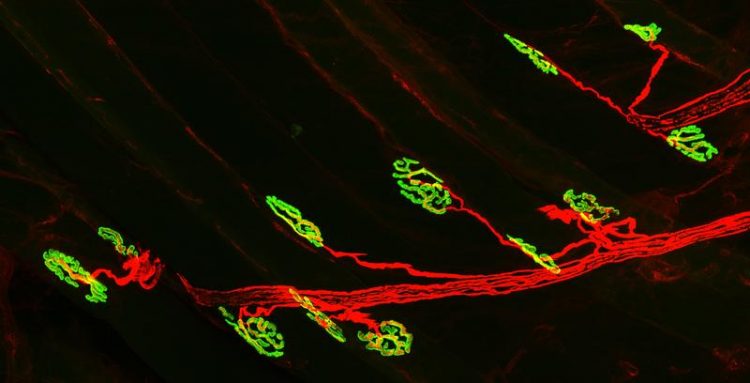One or the other: Why strength training might come at the expense of endurance muscles

The neuromuscular junction (NMJ): innervation of the acetycholine receptors (green) on the muscle fiber by the motor neuron (red). Image: University of Basel, Biozentrum
Fitness clubs are booming: New gyms are springing up like mushrooms. More and more people are striving to build up and strengthen their muscles. But what exactly happens in the muscle during training?
In their recent work, Prof. Christoph Handschin’s research group at the Biozentrum, University of Basel, has more closely studied strength muscles and the myokine brain-derived neurotrophic factor (BDNF), which plays an important role in the formation of strength muscle fibers.
Handschin’s team has demonstrated that this factor is produced by the muscle itself and remodels the neuromuscular synapses, the neuronal junctions between the motor neurons and muscle. BDNF not only causes the strength muscles to develop, but at the same time leads to endurance muscle fiber number decline.
BDNF acts on muscles and synapses
Generally, it is differentiated between two types of muscle, depending on the type of fibers they are made of: There are the slow-twitch fibers for endurance muscles, which are formed mainly during endurance sports. Marathon runners primarily exercise this type of muscle. A great deal less well studied is the second form of muscle consisting of fast-twitch fibers. These strength muscles gain in volume during strength training and provide particularly great muscular power.
Christoph Handschin’s team has now studied the hormone-like neurotransmitter from the myokine family in the mouse model. Myokines are released by the muscle during contraction. “It is interesting that BDNF is produced by the muscle itself and not only exerts an influence on the muscle. At the same time, it affects the neuromuscular synapses, which are the junctions between the motor neurons and muscle,” explains Handschin.
BDNF converts endurance muscles into strength muscles
This remodeling of the neuromuscular synapses during strength training results in the body developing more strength muscle fibers. “However, strength muscle growth occurs at the expense of the endurance fibers. More precisely, through the release of BDNF, the endurance muscles are transformed into strength muscles”, clarifies Handschin. This makes BDNF a factor proven to be produced by the muscle itself and to influence the type of muscle fibers formed.
Relevance to muscle training and age-related muscle atrophy
The new knowledge gained about the myokine BDNF also provides a possible explanation for the decrease in endurance musculature seen as a result of strength training. This correlation is already being taken into account in the training plan for high performance sports. Particularly in sporting disciplines such as rowing, which are geared towards strength and endurance, the muscle remodeling must be considered.
Moreover, in a follow-up study, the research group showed that in muscle lacking BDNF the age-related decline in muscle mass and function is reduced. “We didn’t expect this result”, says Handschin. “It also makes the findings interesting for treatment approaches for muscle atrophy in the elderly.”
Prof. Dr. Christoph Handschin, Universität Basel, Biozentrum, Tel. +41 61 207 23 78, E-Mail: christoph.handschin@unibas.ch
Heike Sacher, Universität Basel, Biozentrum, Kommunikation, Tel. +41 61 207 14 49, E-Mail: heike.sacher@unibas.ch
Julien Delezie, Martin Weihrauch, Geraldine Maier, Rocío Tejero, Daniel J. Ham, Jonathan F. Gill, Bettina Karrer-Cardel, Markus A. Rüegg, Lucía Tabares, and Christoph Handschin
BDNF is a mediator of glycolytic fiber-type specification in mouse skeletal muscle
PNAS (2019), doi: 10.1073/pnas.1900544116
Media Contact
More Information:
http://www.unibas.chAll latest news from the category: Life Sciences and Chemistry
Articles and reports from the Life Sciences and chemistry area deal with applied and basic research into modern biology, chemistry and human medicine.
Valuable information can be found on a range of life sciences fields including bacteriology, biochemistry, bionics, bioinformatics, biophysics, biotechnology, genetics, geobotany, human biology, marine biology, microbiology, molecular biology, cellular biology, zoology, bioinorganic chemistry, microchemistry and environmental chemistry.
Newest articles

Innovative vortex beam technology
…unleashes ultra-secure, high-capacity data transmission. Scientists have developed a breakthrough optical technology that could dramatically enhance the capacity and security of data transmission (Fig. 1). By utilizing a new type…

Tiny dancers: Scientists synchronise bacterial motion
Researchers at TU Delft have discovered that E. coli bacteria can synchronise their movements, creating order in seemingly random biological systems. By trapping individual bacteria in micro-engineered circular cavities and…

Primary investigation on ram-rotor detonation engine
Detonation is a supersonic combustion wave, characterized by a shock wave driven by the energy release from closely coupled chemical reactions. It is a typical form of pressure gain combustion,…



